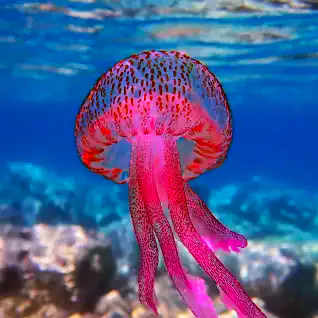Context
Marine researchers along the Visakhapatnam coastline in Andhra Pradesh reported an occurrence of a bloom of venomous jellyfish.
- Pelagia noctiluca, has been identified as the species behind this particular phenomenon.
Enroll now for UPSC Online Course
About Pelagia Noctiluca
- Pelagia noctiluca is a venomous jellyfish species.
 Common Names: mauve stinger or purple-striped jellyfish
Common Names: mauve stinger or purple-striped jellyfish- Lifespan: Two to six months
Features
- Venomous Nature: Its venomous nature can induce various health issues such as diarrhea, severe pain, vomiting, and potentially life-threatening anaphylactic shock.
- Anaphylactic shock is a severe and potentially life-threatening allergic reaction that can develop rapidly in response to an allergen.
- Global Distribution: Tropical and warm-temperature seas
- Distinctive Features: Unlike many other jellyfish species, Pelagia noctiluca has stingers not only on its tentacles but also on its bell.
| Factor affecting Jellyfish blooms |
Explanation |
| Natural Cycles |
Jellyfish populations naturally fluctuate. Blooms can occur due to these variations. |
| Ocean Temperature Rise |
Warmer waters can be ideal for jellyfish reproduction and growth, increasing their populations. |
| Eutrophication |
Excess nutrients from runoff can lead to plankton blooms, which jellyfish feed on. This can indirectly boost jellyfish numbers. |
| Overfishing |
Overfishing of natural predators of jellyfish can lead to a decrease in those populations, allowing jellyfish to thrive without competition. |
| Habitat Modification |
Coastal development and changes in water flow can disrupt ecosystems, favoring jellyfish over other species. |
-
- Bioluminescence: One of the unique characteristics of Pelagia noctiluca is its ability to produce light in the dark, making it bioluminescent.
-
Jellyfish Blooms:
- Jellyfish blooms occur when species populations rapidly increase due to heightened reproduction rates.
- Causes: Rising ocean temperatures contribute to frequent jellyfish blooms by creating favorable breeding conditions.
Implications of the Recent Jellyfish Bloom Along the Visakhapatnam Coastline
Ecological Implications:
- Threat to human health: The Pelagia noctiluca jellyfish is venomous and can cause serious health problems, including allergic reactions, in humans.
- Disruption to the ecosystem: Jellyfish blooms can disrupt the food chain and impact other marine life.
- Potential impact on prey populations: The Pelagia noctiluca jellyfish feeds on plankton and small fish larvae.
- Oxygen Depletion and Hypoxia: As jellyfish die and sink to the ocean floor, they decompose.
- This decomposition process consumes oxygen, leading to localized oxygen depletion in the water column.
- In extreme cases, this can result in hypoxic zones, where oxygen levels are too low to support most marine life.
Enroll now for UPSC Online Classes
Economic Implications:
- Impact on Tourism and Coastal Economy:
- Blooms of venomous jellyfish can deter tourists from visiting affected beaches.
- It can result in economic losses for hotels, restaurants, and other tourism-related businesses.
- Impact on Fishing Industry:
- Depletion of fish larvae and disruption of the food chain due to jellyfish blooms can lead to decreased fish populations, resulting in lower catches and income for fishermen.
- Beach Management Expenses:
- Depending on the severity of the bloom, resources may be required for beach closures, signage, or mitigation efforts, leading to additional expenses for local governments.
Also Read: Artificial Reefs In Vizhinjam To Boost Fish Populations
![]() 8 Apr 2024
8 Apr 2024
 Common Names: mauve stinger or purple-striped jellyfish
Common Names: mauve stinger or purple-striped jellyfish
